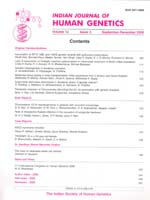
|
Indian Journal of Human Genetics
Medknow Publications on behalf of Indian Society of Human Genetics
ISSN: 0971-6866 EISSN: 1998-362x
Vol. 8, Num. 2, 2002, pp. 73-74
|
Indian Journal of Human Genetics, Vol. 8, No. 2, Jul-Dec, 2002 pp. 73-74
Case Report
Down syndrome with Fragment X - A case Report
Aruna N, Preetha Thilak, Sayee Rajangam
Division of Human Genetics, Department of Anatomy, St. Johns' Medical College, Bangalore - 560034.
Address
for correspondence: Dr. Aruna N., Assistant Professor, Division of Human
Genetics, Department of Anatomy, St. Johns' Medical College, Bangalore-560034.
Email:sjmcanat@satyam.net.in
Code Number: hg02015
This article reports a case of four-month-old female
infant referred to Division of Human Genetics, St. Johns'
Medical College, for karyotyping with suspicion of Down
syndrome. On karyotyping all analysed spreads showed trisomy
21 but a few spreads (6.66%) showed fragment X. X
was broken at the centromere and both short and long
arms were present in the spread. GTG bands of the
two fragments correlated with the normal X counter parts.
The mechanism behind isochromosome formation is
discussed. Thus, this case is free trisomy 21 for Down syndrome
and a mosaic for the X structural anomaly.
Key words: Isochromosome, trisomy21, fragment X, delX.
Introduction
Isochromosome, a structural chromosomal anomaly shows loss of one arm of the
chromosome with duplication of the other. Isochromosome is formed when the
centromere divides transversely rather than longitudinally during anaphase
stage of a cell division. The most commonly encountered isochromosome is that
of long arms of x, which accounts for approximately 20% of all cases of turner
syndrome1. Down syndrome is the commonest autosomal chromosomal
anomaly with an incidence of 1in 700 to 1000 live births.
This article reports the presence of a fragment x along with trisomy 21 and
also the mechanism of isochromosome formation.
Case report
A four-month-old infant, second birth order, born to non-consanguineous couple
aged 25 and 29 years was referred to division of human genetics, department
of anatomy, st. John's medical college with clinical
suspicion of Down syndrome for karyotyping.
The child was phenotypically female and had
most of the common dysmorphic features of down
syndrome like short palpebral fissures, mongoloid slant,
epicanthic folds, hypertelorism, depressed nasal bridge,
small mouth, high arched palate and bilateral
clinodactyly. Weighed 5.5 kgs and had not attained
any developmental milestones.
Neonatal history revealed septicemia, right
ectopic kidney and anorectal malformation for which
sigmoido-colostomy has been performed. First pregnancy
ended in a spontaneous abortion with 6 weeks of
amenorrhea. Antenatal history was insignificant except for
detection of ectopic kidney in the fetus by ultrasonogram
during 8th month. Family history was non-significant.
Investigations
Cytogenetic analysis was done with peripheral
blood lymphocyte culture and gtg banding. 30
metaphase spreads were analysed, all spreads showed free
trisomy 21, but 2 spreads (6.66%) showed 48 chromosomes.
In these spreads in addition to the 44 autosomes, one
extra 21, only one normal X and two fragments
were observed. Gtg identified these two fragments
with centromeres as of X origin. X was broken at
the centromere and both short and long arms were
present in the spread. Hence the Karyotype: 47, XX+21
/ 48,X+21+ del Xp (pter®centromere) + del Xq
(centromere®qter). (in view of non-cooperation
neither
repeat culture nor parental karyotyping could be
carried out.)
Discussion
On review of literature, Down syndrome has been known to be associated with Klinefelter syndrome,
Turner syndrome. The mechanism behind the formation of
the observed karyotype in the proband has been
discussed. Trisomy 21 is due to meiotic non-disjunction of 21
in one of the parental gametogenesis. It could also be
due to mitotic non-disjunction during first cleavage of
zygote with subsequent loss of the cell line with
45 chromosomes resulting in free trisomy. Zygote
being prone for non-disjunction seems to become prone
for further mitotic errors in other
chromosomes2 especially the X. One of the mitotic errors could be
the isochromosome formation of X where the
centromere splits transversely resulting in isochromosome of its
short i (Xp) or long i (Xq) arms.
Analysed spreads have shown trisomy 21 (47 chromosomes) in all spreads. But,
in 2 spreads
48 chromosomes were seen. 48 includes all
autosomes, one normal X, one extra 21, one short arm of X and
one long arm of X. The short arm of X was present from
its tip that is telomere to the X centromere. Likewise,
the long arm was present from its tip to centromere.
Thus the karyotype becomes 47, xx+21 / 48, x+21+ del
x
(pter®centromere) + del X (centromere®qter)
63.6%/6.6%. Thus, this case is free trisomy 21 for
Down syndrome and a mosaic for the X structural
anomaly. Gtg bands of the two fragments correlated with
the normal X counter parts. These two cell lines with
X structural anomaly, in further mitotic divisions,
would have resulted in cell lines with either iso
x p or iso X q or 45, X. In this study, coincidentally the
reproducible metaphases spread have been caught at the
correct time showing the steps involved in
isochromosome formation. For the first time, such a case is reported.
Couple was counselled for the low recurrence risk
of <1% keeping in mind their age and insignificant
family history inspite of first pregnancy being an
abortion, second being proband with trisomy 21 and with
mitotic irregularity in the X. Counselling regarding rearing
of the child was given and emphasis was laid on
prenatal diagnostic options during next pregnancy.
Specific request was made for a follow up around the puberty,
to repeat the karyotype to observe the mosaicism
status of the X and its influence on the secondary
sexual features of the proband.
References
- Muller RF, Young ID, Emery's elements of
medical genetics. 11th edn, churchill livingstone; 2001. pp-52.
- Vogel F, Motulsky AG. Human genetics, problems
and approaches. 2nd edn, Springer-Verlag; 1996 pp-59.
Copyright 2002 - the Indian Society of Human Genetics
|
